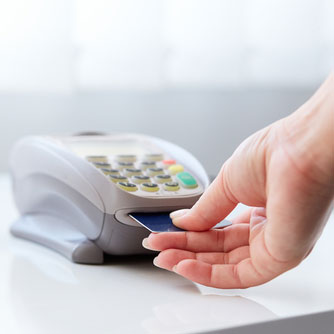There are plenty of reasons to consider using your credit card to pay for bills, including convenience, easy cash flow management and the ability to earn points and rewards. However, it doesn’t come without its drawbacks.
Read our guide to learn what you need to know before deciding whether to pay your bills on plastic.
How to pay your bills with a credit card
There are two main ways you can use your credit card to pay bills: autopay and one-time payments.
1. Autopay
Bills that are charged at a set time each week, month or year can usually be set up as an autopay from your credit card account. This could include your mortgage payments, insurance premiums, utility bills, gym membership, Internet bill and other subscriptions for entertainment services like Netflix.
How do you set up an autopay with your credit card?
- Find out if there is an autopay option through your service provider.
- Provide your chosen credit card account details.
- Confirm the details and authorize the autopay agreement.
What are the key factors to consider when using autopay to pay bills?
- Autopay fees. Some service providers may charge a fee, but most prefer that you set up autopayment, meaning it’s usually a fee-free method of payment. Some providers may even give discounts to those who use autopay as a payment method.
- Declined payment. You could be charged fees twice – once by the service provider and once by your credit card provider.
- Overdraft fees. The card provider might choose to honour the autopayment and may charge you an overdraft fee and default interest.
- Interest charges. The autopayment will be subject to interest fees if you carry a balance on your credit card.
- Cancelled subscriptions. If you cancel a subscription or wish to stop the autopayments, you’ll have to contact both your bank and service provider to ensure that you don’t get charged any fees.
2. One-time payments
One-time bill payments allow you to pay as you go and can be convenient for charges that vary in amounts or are less regular. You might choose to use your credit card to make a one-time payment on your tax bill or for paying off your car repairs in the same way you’d make a regular credit card payment.
| In person | Online |
|---|---|
Swipe, insert or tap your card and follow the prompts to complete the transaction. | Choose “Credit Card” as your payment option and enter your details. |
What are the key factors to consider when using one-time credit card payments to pay bills?
- Card acceptance. Some businesses may limit the type of credit cards that they accept or they may prefer cold hard cash.
- Cash advance transactions. Some bill payments may be treated as cash advances if the business you’re trying to pay isn’t setup to accept credit card payments. Your credit card provider will process the payment as a cash advance and charge you the cash advance interest rate as well as a cash advance fee.
- Credit card surcharges. Although it is illegal for most merchants to charge a surcharge in Canada, there are select merchants that are allowed to charge them if they notify the customer at the point of sale.
- Interest charges. If the business accepts credit card payments, the transaction will typically be treated as a purchase. This means you can enjoy an interest-free period between 21 and 55 days, as is the case for all purchase transactions. The length of the grace period will depend on the credit card that you have.
Earning rewards for paying your bills with a credit card
When it comes to the perks of paying your bills with a credit card, we find that it’s usually more about the rewards points than anything else. The restricting and limiting of points can vary significantly between credit cards, so refer to your credit card’s terms and conditions or contact your credit card provider before making a payment to earn rewards.
Most of the time, the relevant clause pertains to “eligible transactions”, where they state whether or not such a transaction is eligible for earning rewards points. Note that eligible transactions don’t usually apply to other types of bills, such as gym membership fees.
Earning credit card rewards while making bill payments

Let’s look at Annie’s monthly expenses and how she can earn rewards for her regular bill payments:
- Entertainment streaming service: $9.99 per month ($119.88 per year)
- Gym membership: $80 per month ($960 per year)
- Telecommunications: $200 per month ($2,400 per year)
- Electricity: $500 per quarter ($2,000 per year)
She decides to get a rewards credit card which earns two points per dollar spent on gas, utilities and groceries and one point on everything else. After checking and learning that there are no fees involved, Annie sets up all her above payments as an autopayment from this account.
Over a year, Annie earns:
- Entertainment streaming service: 119 points
- Gym membership: 960 points
- Telecommunications: 4,400 points
- Electricity: 4,000 points
Total: 9,479 points per year
Annie can exchange these points for gift cards, merchandise or a cash credit.
Bottom line
While autopayments can be a cost-effective and convenient way to schedule and manage your cash flow, be sure to check for hidden and potential fees that may become costly. If you’re looking to maximize your rewards points earnings, using your credit card to pay for regular everyday purchases and expenses can also be an efficient way to build up your points.
Frequently asked questions
More guides on Finder
-
5 Home Trust Secured Visa Card Alternatives
Compare five cash advance apps and secured credit cards to find the best alternative to the Home Trust Secured Visa.
-
5 Capital One Secured Mastercard Alternatives
Compare Capital One secured credit card alternatives when you need to build credit or access a short-term loan.
-
5 Neo Secured Credit Card Alternatives
Build credit or get an easy short-term loan with these alternatives to a Neo Financial Secured Mastercard.
-
4 best credit cards for fair credit in Canada
Check out the best credit cards for fair credit, and learn how a fair credit score of 560-659 can impact your card options.
-
US dollar credit cards in Canada
Do you travel, work or spend money in the US frequently? Find out if a US dollar credit card is the right fit for you.
-
What credit score is needed for a credit card in Canada?
Find out about the minimum credit score for a credit card in Canada, and compare your card options.
-
Using a credit card internationally
Going abroad and wondering whether you can use your credit card while travelling? Here’s the lowdown on credit cards vs. cash, fees, and which cards to get.
-
What’s the best credit card for kids & teens under 18 years old?
Find out how old you have to be to get to get a credit card for teens in Canada, and learn how your child can qualify if they’re under 18.
-
Best credit cards in Canada with instant approval
Find out how you can apply for an instant approval credit card in Canada and get a response within 60 seconds.
-
What is the most prestigious credit card in Canada?
Discover the features, fees and eligibility requirements of the most prestigious credit cards in Canada.
